Scientists suggest that about 2/3 of the world's population are affected by this or that parasitic disease. Among the various parasites in the human body, there are the most dangerous, which not only cause discomfort to the patient, but can also cause the appearance of dangerous complications, which can lead to death. In our article we will tell you all about parasites, that is, we will describe the most terrible parasites and list the symptoms of the most dangerous helminthiasis.
Varieties of parasites
There are different types of worms and protozoa that live in the human body:
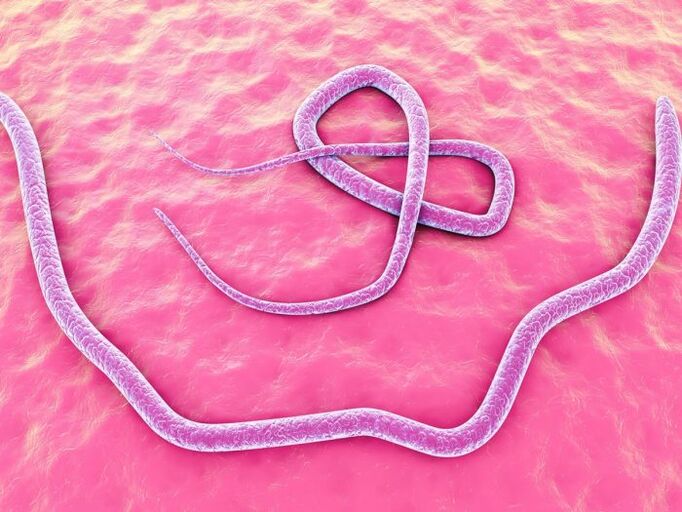
- Helminths. These worms live most often in the intestines, but it is possible for them to settle in the liver, brain, lungs, heart, kidneys, muscles and other organs. Worms cause dangerous diseases and complications.
- Parasitic and multicellular protozoa (protozoan parasites). These pests are common in different latitudes. These human parasitic protozoa can infect the intestines, eyes, brain, esophagus, heart, muscles, as well as nerves, liver, skin and even the genitourinary system. The most common parasitic protozoa that live in humans are lichens, lamblia, toxoplasma, Trichomonas, blastocysts, etc.
- Other organisms that are also parasites of humans are lice, insects, ticks and fly larvae. Its name is ectoparasites. They can parasitize not only on the surface of the skin, but also on wounds, hair follicles and eyelashes.
- Other parasites are species that most commonly affect the subcutaneous tissue, but can parasitize in the urethra and nasopharynx. These are the larvae of some flies, mosquitoes, sand fleas.
We have listed the main types of parasites in humans. But if we talk about the types of parasites that live in the human body in our latitudes, the most terrible of them are the following:
- pig's tapeworm; wide tape
- ;
- pinworms;
- Chinese chance;
- roundworm; fluke;
- Trichinella; alveococcus;
- whipworm
- dwarf tapeworm;
- bullish tapeworm; liver worm; pulmonary worm;
- echinococcus.
The diseases they cause
The most dangerous parasites that live in the human body can cause a variety of diseases. Often, a disease caused by a particular parasite has the same name as it does. Thus, several types of parasites in the human body can cause the following diseases:
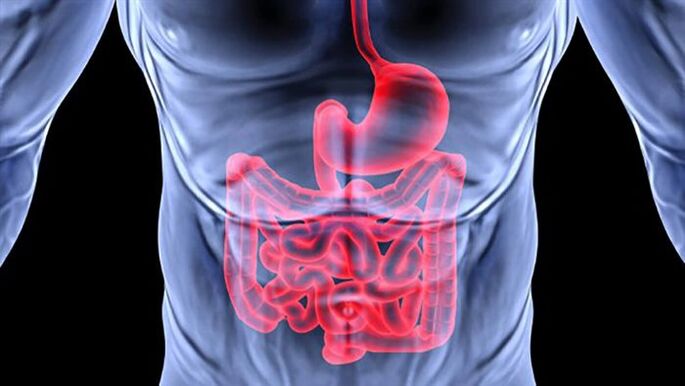
- certain parasites within a person (worms) cause trematodes;
- cestodoses occur when tapeworms are affected;
- if an adult or child has roundworms in the intestines, nematodes are diagnosed; leeches cause hirudinosis;
- Anthocephalosis is caused by scratches.
However, parasites in the human body can infect more than one organ. Depending on the location of the parasites in the human body, the following parasitic diseases are distinguished:
- If the eyes are affected, onchocerciasis, demodicosis, cysticercosis and myiasis may occur;
- Diseases of the gastrointestinal tract, which are caused by single-celled and helminth parasites, - ascariasis, trichinosis, ankylostomiasis, enterobiasis, intestinal myiasis and metagonimiasis;
- Brain diseases - echinococcosis, toxoplasmosis, alveococcosis and cysticercosis;
- Dermatological diseases - demodicosis, lice, scabies, pulicosis, thrombidiasis, phtyriasis;
- Pulmonary pathologies - echinococcosis, ascariasis, acariasis, alveococcosis, tominxose, etc. ;
- Liver diseases - opistorchiasis, alveococcosis, echinococcosis, clonorchiasis;
- In the mouth, ears and mouth, parasites can cause different types of myiasis;
- Cardiac pathologies - heartworm and echinococcosis;
- Diseases of the genitourinary system - alveococcosis, urate myiasis, echinococcosis;
- Vascular pathologies - filariasis and schistosomiasis.
Symptoms
What are the parasites of the human body, we have already considered. Now, let's examine the main symptoms caused by the simplest human parasites and various types of worms. It is important to note that cysts of pathogenic worms and protozoa often become the cause of the infection, which can remain in the external environment for a long time, waiting for the right moment.  When in favorable conditions of a person's internal environment, the larvae emerge from the cysts, which actively develop even to adults.
When in favorable conditions of a person's internal environment, the larvae emerge from the cysts, which actively develop even to adults.
Separately, it is worth explaining what cysts are. Most of the time, cysts form the simplest single-celled organisms, bacteria and protists. Protozoan cysts are a temporary form of an organism's existence in adverse conditions. In fact, it is a protective shell. Cyst formation occurs at a certain stage in the parasite's life cycle or in unfavorable conditions.
Ascariasis

The disease is caused by roundworms. These parasites can live exclusively in the human intestine. The symptom complex depends on the intensity of the invasion and the patient's age. Common signs of the disease are:
- allergic itchy rash (such as a vesicular or urticarial rash);
- feverish state;
- general malaise;
- excessive sweating; weakness of
- ; enlarged liver;
- in the migratory phase: shortness of breath, cough, wheezing in the lungs;
- loss of appetite;
- diarrhea and constipation;
- nausea;
- on the side of the central nervous system: irritability, impaired sleep and memory, seizures, meningitis;
- liver abscess, obstructive jaundice, appendicitis, pancreatitis and obstruction can develop with massive invasion.
Teniarinhoz
This disease causes bovine tapeworm. In the initial stage, the disease is asymptomatic and can last for years. Sooner or later, the following symptoms appear:
- weight in the epigastrium;
- nausea, heartburn;
- increased salivation;
- choking;
- appendicitis, intestinal obstruction, bile duct block;
- loss of body weight in the context of increased appetite; vitamin deficiency;
- allergic reactions;
- dizziness, weakness, sleep disorders, increased nervousness and irritability;
- arterial hypertension and tachycardia.
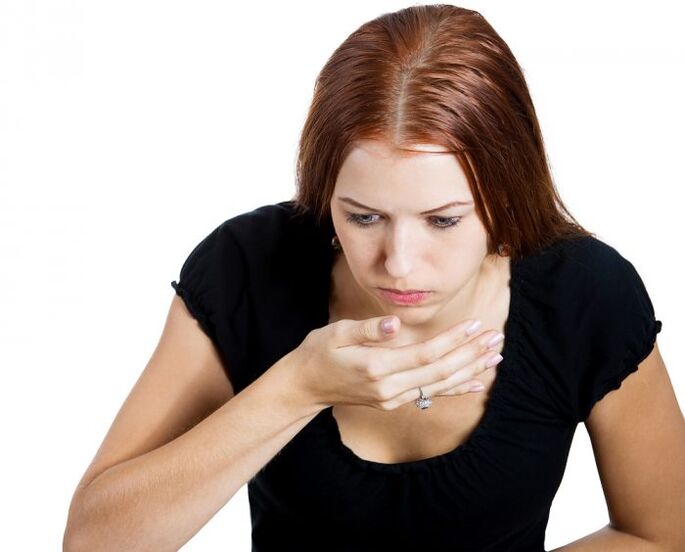
Enterobiasis
Pinworms cause this disease. This is the most common parasitic disease. Its symptoms are as follows:
- itching in the anus, worse at night;
- scratches and redness in this area;
- sleep suffers, bruxism, drowsiness, lethargy appear;
- loss of appetite;
- abdominal pain, urinary incontinence in children;
- unstable stools, nausea, flatulence, vomiting;
- allergic reactions.
Toxocariasis

Toxocara worms can parasitize in various tissues and organs of a person. However, regardless of the location, they always cause allergic reactions in the body, proceeding as follows:
- Rash similar to mosquito bites. The rash can appear on various parts of the body.
- Bronchial asthma, which manifests itself as a persistent dry cough with a small amount of sputum.
- Quincke's edema. A person has swelling of the skin on the face and neck, which can cause choking and death.
With the exacerbation of toxocariasis, the patient's temperature rises, symptoms of intoxication appear with loss of appetite and headaches, enlarged lymph nodes.
Necatorosis (hookworm)
This disease is caused by helminths called nekator and hookworm. The invasion is manifested by the following symptom complex:
- When the larvae are introduced through the skin, dermatitis, hives and various skin rashes appear. At the site of penetration, there is swelling, itching and burning. The invasive period lasts up to 12 days.
- The migratory phase is also accompanied by allergic manifestations. In this case, the respiratory tract is damaged, and bronchitis, pneumonia, tracheitis and laryngitis may occur. The patient presents with fever, cough, shortness of breath and hoarse voice.
- In a few months, the intestinal stage of the disease begins. At this stage, the symptoms of iron deficiency anemia and duodenitis are present. The patient has increased irritability, fatigue and sleep disorders. Women have menstrual irregularities.
Important! In childhood, hookworm infection can cause mental and physical retardation.
Giardiasis
Giardia is a parasitic protozoan disease. A quarter of the population is an asymptomatic carrier of this microorganism. In the acute phase, the following signs appear:

- malfunction of the gastrointestinal tract;
- the patient is plagued by pain in the right hypochondrium and in the area around the navel;
- flatulence, decreased appetite, belching, nausea;
- diarrhea alternates with constipation, there may be frequent foamy stools (up to 5 times);
- with subacute course, intestinal symptoms persist, the patient loses weight;
- with intoxication from massive invasion and fever;
- children have itching, hives and fainting;
- During the coprogram, protozoan cysts are found in the stool.
Amebiasis
The disease is caused by a histological amoeba. The disease can be asymptomatic or symptomatic. There are two forms of the disease: extraintestinal and intestinal. These protozoa can affect the brain, lungs, skin and the genitourinary system. But the most common is intestinal amebiasis. Its symptoms are as follows:
- at the beginning of the disease, diarrhea appears with abundant foamy stools and then gelatinous stools, such as raspberry jam, come out. Its frequency is up to 20 times a day;
- severe pain located on the right side of the abdomen;
- mild subfebrile condition;
- after 6 weeks, the acute process may slow; The
- exam can reveal protozoa in the stool.
Important! Amoebiasis never goes away on its own and often relapses. If left untreated, an amoeba is formed, which leads to intestinal obstruction.
Diphyllobotriasis
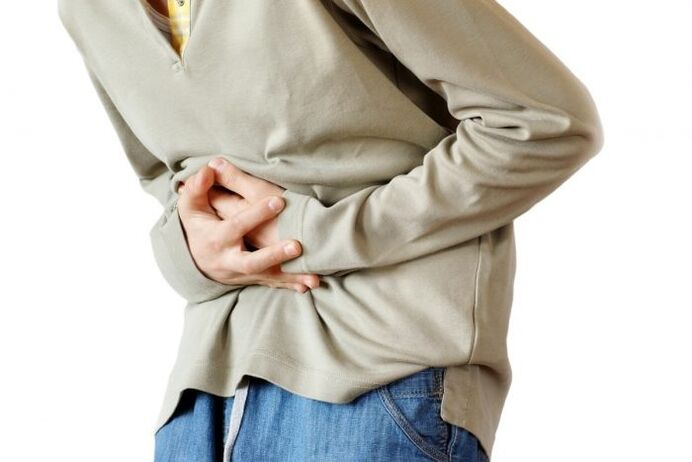
The common tapeworm is to blame for this disease. This cestoid representative causes the following clinical picture of the disease:
- weight loss, erratic stools, decreased appetite;
- low temperature; fatigue;
- abdominal cramps;
- anemia, weakness, dizziness, increased heart rate;
- fragments of the worm can be found in the feces;
- painful cracks appear in the mouth; depression
- and increased irritability.
Teniosis
The disease is caused by the pig's tapeworm. The parasite is located in the small intestine and causes the following symptoms:
- constipation, vomiting, diarrhea, nausea;
- vomiting and feces may contain segments (proglottids) of the parasite;
- anal itching, abdominal pain;
- sleep suffers, dizziness appears.
Echinococcosis
The echinococcus can be asymptomatic for a long time. Then pains appear in the area of formation of an echinococcal cyst. Symptoms are typically characteristic of neoplasms of a particular organ. When the cyst ruptures, general intoxication, anaphylactic shock and hives arise.
Types of parasites that live in the human body
All types of parasites in the human body have a detrimental effect on your health. They infect organs, feed on nutrients necessary for human life and release harmful toxic substances. Therefore, it is very important to get rid of them in a timely manner.
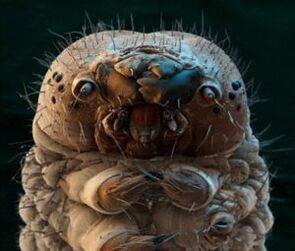
The human body is affected by several parasites, some live inside the body, others on its surface. They differ in size, in the way they enter the body, in the characteristics of their vital functions.
Which parasites live in the human body? how to get rid of them? What preventive measures are there? These issues will be discussed below.
Classification of parasites
Human parasites are very common, they are divided into groups:
- Endoparasitesare organisms that parasitize within a person. This group, in turn, is divided into protozoa (formed by a single cell) and helminths (worms). The simplest parasites in the human body are amoeba, lamblia, Trichomonas, toxoplasma. As for worms, here again there is a division into round worms (nematodes), flat and tapeworms.
- Ectoparasitesare organisms that parasitize on the surface of the human body - lice, ticks, fleas, bedbugs. In addition to feeding on human blood, they cause great discomfort (stings, burns, skin wounds), they carry very dangerous diseases: typhus, anthrax, trypanosomiasis and others.
- Giardia.Giardiasis infection is a fecal-oral mechanism. After the cysts (parasites not yet formed, covered by a protective membrane) are removed from the anus of a sick person, they spread to vegetables, fruits and other food products. Through poorly washed hands, stagnant water, insufficiently washed fruits and vegetables, the cysts enter the human oral cavity, from where they safely reach the intestine, where they again become adults and multiply again. The result is a vicious cycle that will continue until adequate treatment is provided and hygiene measures are followed. The symptoms of the disease are weakness, fatigue, headache, diarrhea, abdominal pain and bloating. Itching in the anus, skin rashes, bronchial asthma can occur. The pathology is characterized by weight loss, anemia and weakened immune system. Treatment - Metronidazole, Furazolidone, Tinidazole. The dosage is prescribed by the doctor.
- Toxoplasma.Infection with these protozoa occurs through contact with infected pets. In this case, the person is an intermediate host, since the parasite's sexual development cycle occurs in the animal's body. The disease is manifested by prolonged rise in temperature to subfebrile levels, general signs of intoxication, the patient has enlarged lymph nodes, pain in the joints and muscles. In addition, the functions of the gastrointestinal and visual tracts are impaired, the central nervous system may suffer, there are signs of heart disease and the endocrine system. Complex treatment is prescribed - antibiotics from the group of tetracyclines and sulfonamides.
- Trichomonas.Trichomonas is sexually transmitted, the risk of contact infection is minimal, but it still exists. Symptoms of the disease in women are itching, redness of the genitals, a burning sensation and foamy discharge. Men may have difficulty urinating and discharge. Treatment - anti-trichomonas drugs.
Pinworm is an intestinal parasite
The most famous internal parasites are the pinworms. They live in the intestines and cause a disease called enterobiasis. This type of parasite affects not only humans, but also monkeys. Risk group - children of preschool age, according to statistics, enterobiasis is diagnosed in half of children aged 2 to 10 years.
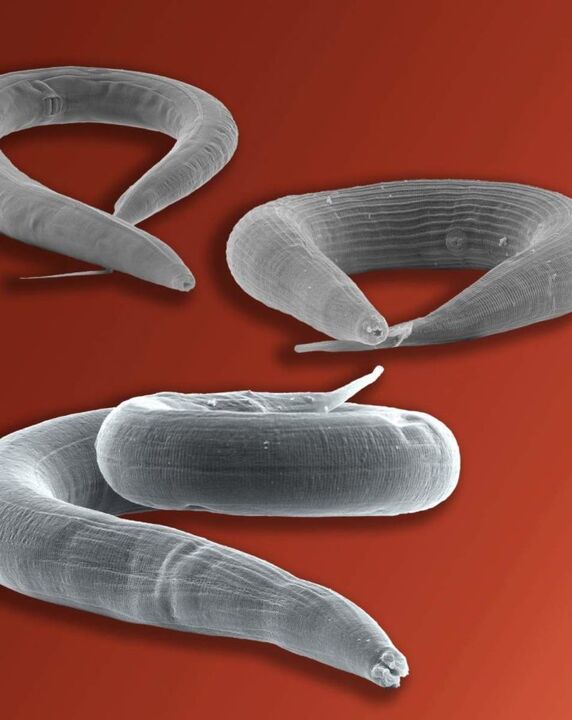
Worms are transmitted from person to person, you can be infected by any object that a sick person has used or by a handshake. The main condition for the transfer of moth eggs is not to wash your hands after contact, especially before eating. Worms, or rather their eggs, can be transported by flies and cockroaches.
Pinworms can only live in the intestines, they are especially comfortable in the thin section, in the colon and cecum. For mating, the parasites select the ileum, from where the female crawls out of the anus and lays the eggs in it. Symptoms of worms in the body are itchy anus, allergies, fatigue, anemia, abdominal pain, tiredness.
Levamisole, mebendazole, albendazole and other anthelmintic drugs are prescribed for the treatment of enterobiasis. Pinworm prevention is based on hand hygiene. They must be washed after visiting any public place.
Roundworms - roundworms
The length of an adult can reach 40 cm. Roundworms live in the human intestine, their eggs hatch naturally, then continue their development in the soil, where they remain until they enter the human body again. Dirty hands and dirty vegetables and fruits are forms of contagion of worms. Roundworm eggs are covered by a shell that does not dissolve in the human stomach and allows roundworms to survive and enter the intestine, where mature individuals thrive.
Ascariasis can be asymptomatic for a long time. Then the symptoms appear, which depend on the location and stage of development of the parasite. In the first migratory phase of ascariasis, the patient worries about fever, cough with sputum, skin rashes, migraines, enlarged lymph nodes, liver and spleen may appear. In the late phase, when the parasite has already entered the intestine, disturbances in the stools are observed (dysentery, symptoms similar to those of cholera, signs of typhoid fever may occur). There are painful sensations in the abdomen, a marked loss of weight and fatigue.
Wide ribbon
Infection with this parasite occurs in fish. This is the intermediate host of the worm. It is not necessary to eat for the infection, sometimes contact with infected fish is enough. That is why it is so important to handle your hands, the knife, the board very carefully after cutting the fish.
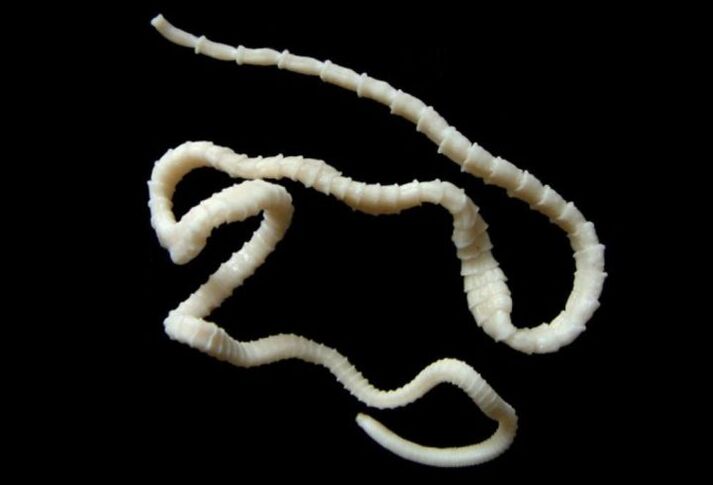
Neither worms nor their larvae are transmitted from a sick person to a healthy person. Symptoms of infection are nausea, vomiting, abdominal pain, increased or decreased appetite, dyspeptic disorders. The first signs of the disease may appear a month or two after infection. As a result of the prolonged presence of the parasite in the human body, pale skin, headache, increased heart rate, decreased blood pressure, weakness and anemia occur. The treatment aims to kill the worm. To do this, use Praziquantel, Niclosamida.
Bull tapeworm
The bovine tapeworm can grow up to 12 m in length. It is a hermaphrodite that can produce more than 100, 000 eggs, which are excreted in the droppings. Eggs fall to the ground, then to plants, these plants are eaten by cattle. In an animal's body, the eggs turn into larvae, which are located in the muscles. If a person eats contaminated meat, the larvae enter the intestine. Larvae are not transmitted from person to person.
Adult worms have a head with four suckers, a neck and a body consisting of segments. The number of segments is growing steadily, mature segments can separate from the worm and crawl out of the human intestine.
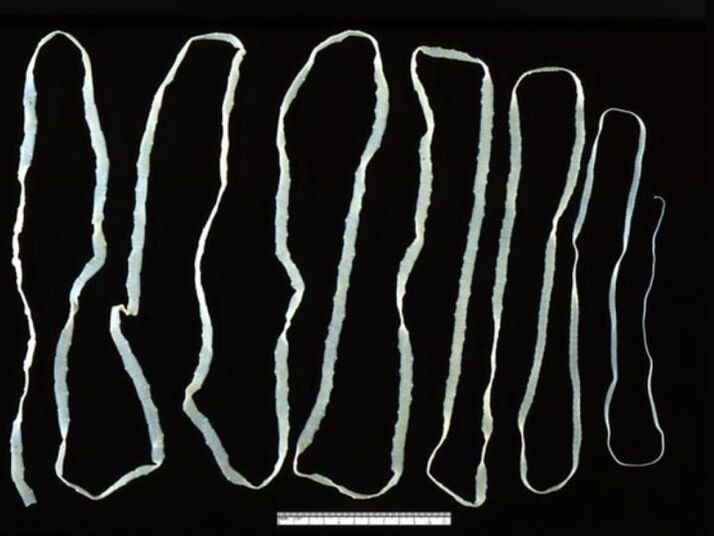
The symptoms of the disease are nausea, vomiting, dyspeptic disorders, increased salivation, dizziness, weakness, nervousness, fatigue, abdominal pain of uncertain location, allergies, fluctuations in appetite.
For the removal of bovine tapeworm from the body, there is a scheme consisting of 3 stages: preparatory (cleaning the body), treatment with antiparasitic agents (Biltricide, Praziquantel, Niclosamida), recovery (diet, herbal medicines).
Pork tapeworm
A person can become infected with pig tapeworm through dirty hands, undercooked meat, dirty water, an infected person can release tapeworm segments and larvae into the environment with vomit and feces. 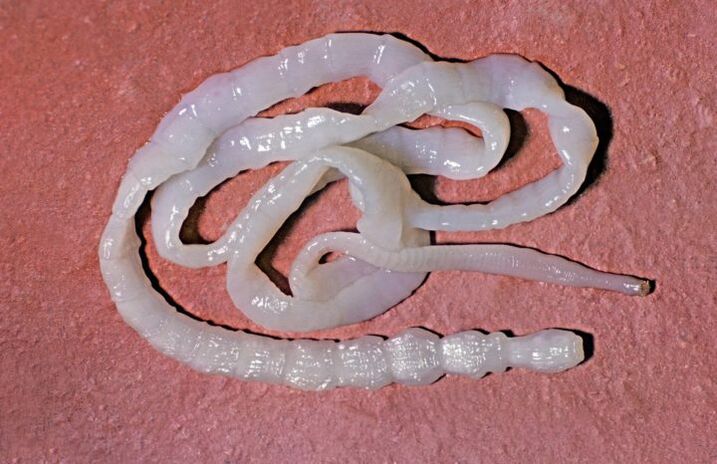 The worm can live in the human body for up to 15-17 years, adheres to the intestinal mucosa and its larvae can spread throughout the body with blood flow and attach to any organ. It is especially dangerous if the larva enters the brain.
The worm can live in the human body for up to 15-17 years, adheres to the intestinal mucosa and its larvae can spread throughout the body with blood flow and attach to any organ. It is especially dangerous if the larva enters the brain.
The pig is the intermediate host; people who have frequent contact with raw meat are at the greatest risk of contracting the parasite. The pork chain can be infected both by contact and by eating meat treated with insufficient heat. In order for all larvae of the pork tapeworm to be destroyed in the meat, the meat must be cooked for a long time or frozen for 2 to 3 weeks.
Swine tapeworm can affect the small intestine, liver, brain, visual organs, muscles, etc. If the tapeworm affects vital organs, the person may suffer paralysis or even death.
Symptoms of swine tapeworm: allergic reactions, abdominal pain, nausea and vomiting, weakness, dizziness, headache, weight loss, itchy anus. The worm infects the intestinal mucosa, so the symptoms are very similar to those of enteritis.
Treatment consists of taking medications that have a paralyzing effect on the worm, so it cannot stay on the intestinal walls and get out. But at the same time, it emits a lot of toxic substances, which can cause anaphylactic shock in a person. Therefore, treatment should only be carried out under the supervision of a doctor.
Parasites in the mouth
Human mouth parasites can be most often represented by the following species:
- Trichomonas;
- Diptera larvae (oral myiasis).
The clinical picture may be as follows:
- allergies; weakness
- , weight loss;
- foul odor from the mouth;
- sensation of movement in the larynx;
- itching and sweating;
- nausea, loss of energy.
The worms that live in the mouth can destroy the teeth, create purulent deposits on the mucous membrane and on the tongue. The treatment is prescribed only by a doctor who takes into account the existing symptoms, as well as the types of parasites. A prerequisite for treatment is the examination of all persons in contact with the patient.
Summary
Above, not all were considered, even the most common parasites that can inhabit the human body. It is important to understand the great danger of this neighborhood: worms in a person can cause very serious consequences and, ultimately, cause the death of its owner. Therefore, it is very important to diagnose the parasites in a timely manner and get rid of them. As for preventive measures, they consist mainly of hygiene and high-quality roasting of the meat consumed.






































